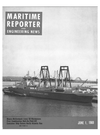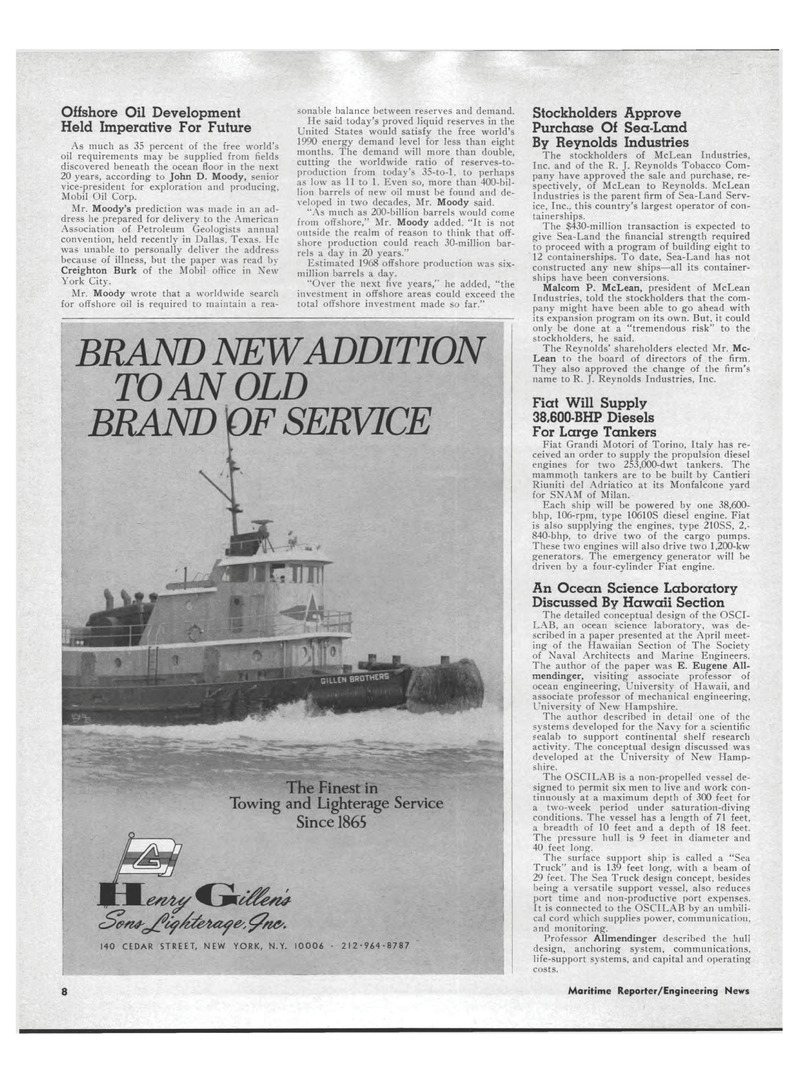
Page 6: of Marine News Magazine (June 1969)
Read this page in Pdf, Flash or Html5 edition of June 1969 Marine News Magazine
Offshore Oil Development Held Imperative For Future As much as 35 percent of the free world's oil requirements may be supplied from fields discovered beneath the ocean floor in the next 20 years, according to John D. Moody, senior vice-president for exploration and producing, Mobil Oil Corp. Mr. Moody's prediction was made in an ad-dress he prepared for delivery to the American Association of Petroleum Geologists annual convention, held recently in Dallas, Texas. He was unable to personally deliver the address because of illness, but the paper was read by Creighton Burk of the Mobil office in New-York City. Mr. Moody wrote that a worldwide search for offshore oil is required to maintain a rea-sonable balance between reserves and demand. He said today's proved liquid reserves in the United States would satisfy the free world's 1990 energy demand level for less than eight months. The demand will more than double, cutting the worldwide ratio of reserves-to-production from today's 35-to-l. to perhaps as low as 11 to 1. Even so, more than 400-bil-lion barrels of new oil must be found and de-veloped in two decades, Mr. Moody said. "As much as 200-billion barrels would come from offshore," Mr. Moody added. "It is not outside the realm of reason to think that off-shore production could reach 30-million bar-rels a day in 20 years." Estimated 1968 offshore production was six-million barrels a day. "Over the next five years," he added, "the investment in offshore areas could exceed the total offshore investment made so far." Stockholders Approve Purchase Of Sea-Land By Reynolds Industries The stockholders of McLean Industries, Inc. and of the R. J. Reynolds Tobacco Com-pany have approved the sale and purchase, re-spectively, of McLean to Reynolds. McLean Industries is the parent firm of Sea-Land Serv-ice, Inc., this country's largest operator of con-tainerships. The $430-million transaction is expected to give Sea-Land the financial strength required to proceed with a program of building eight to 12 containerships. To date, Sea-Land has not constructed any new ships?all its container-ships have been conversions. Malcom P. McLean, president of McLean Industries, told the stockholders that the com-pany might have been able to go ahead with its expansion program on its own. But, it could only be done at a "tremendous risk" to the stockholders, he said. The Reynolds' shareholders elected Mr. Mc-Lean to the board of directors of the firm. They also approved the change of the firm's name to R. J. Reynolds Industries, Inc. Fiat Will Supply 38,600-BHP Diesels For Large Tankers Fiat Grandi Motori of Torino, Italy has re-ceived an order to supply the propulsion diesel engines for two 253,000-dwt tankers. The mammoth tankers are to be built by Cantieri Riuniti del Adriatico at its Monfalcone yard for SNAM of Milan. Each ship will be powered by one 38,600-bhp, 106-rpm, type 10610S diesel engine. Fiat is also supplying the engines, type 210SS, 2,-840-bhp, to drive two of the cargo pumps. These two engines will also drive two 1,200-kw generators. The emergency generator will be driven by a four-cylinder Fiat engine. An Ocean Science Laboratory Discussed By Hawaii Section The detailed conceptual design of the OSCI-LAB, an ocean science laboratory, was de-scribed in a paper presented at the April meet-ing of the Hawaiian Section of The Society of Naval Architects and Marine Engineers. The author of the paper was E. Eugene All-mendinger, visiting associate professor of ocean engineering. University of Hawaii, and associate professor of mechanical engineering, University of New Hampshire. The author described in detail one of the systems developed for the Navy for a scientific sealab to support continental shelf research activity. The conceptual design discussed was developed at the University of New Hamp-shire. The OSCILAB is a non-propelled vessel de-signed to permit six men to live and work con-tinuously at a maximum depth of 300 feet for a two-week period under saturation-diving conditions. The vessel has a length of 71 feet, a breadth of 10 feet and a depth of 18 feet. The pressure hull is 9 feet in diameter and 40 feet long. The surface support ship is called a "Sea Truck" and is 139 feet long, with a beam of 29 feet. The Sea Truck design concept, besides being a versatile support vessel, also reduces port time and non-productive port expenses. It is connected to the OSCILAB by an umbili-cal cord which supplies power, communication, and monitoring. Professor Allmendinger described the hull design, anchoring system, communications, life-support systems, and capital and operating costs. BRAND NEW ADDITION TO AN OLD BRAND OF SERVICE » The Finest in Towing and Lighterage Service Since 1865 140 CEDAR STREET, NEW YORK, N.Y. 10006 ? 212-964-8787 8 Maritime Reporter/Engineering News

 5
5

 7
7
